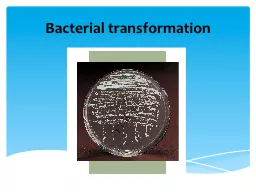

All living things use the same genetic code Each codon corresponds to a specific amino acid regardless of the species We can take a gene from one species and insert it into a different one and still get the same protein ID: 463905
Download Presentation The PPT/PDF document "Bacterial transformation" is the property of its rightful owner. Permission is granted to download and print the materials on this web site for personal, non-commercial use only, and to display it on your personal computer provided you do not modify the materials and that you retain all copyright notices contained in the materials. By downloading content from our website, you accept the terms of this agreement.
Slide1
Bacterial transformationSlide2
All living things use the same
genetic code
Each codon corresponds to a specific amino acid, regardless of the speciesWe can take a gene from one species and insert it into a different one and still get the same protein (same amino acid sequence)
the genetic code is universalSlide3
In addition to the nucleoid DNA, E. coli bacteria contain small circles of DNA called
plasmids;
plasmids
http://en.wikipedia.org/wiki/Plasmid
A plasmid is a small, circular piece of double-stranded DNA Slide4
plasmids
Often, the genes carried in plasmids provide bacteria with genetic advantages, such as
antibiotic resistance.Plasmid DNA
contains coding sequences
(genes) which are expressed by the bacterium (the bacterium produces the corresponding proteins ;Slide5
The cell that receives the piece of DNA (plasmid) is called
transformed cell
Bacterial Transformation:
The
introduction of a piece of DNA, like a
plasmid,
into
a bacterial cellSlide6
Transformation rarely occurs
naturally
;By subjecting bacteria to certain artificial conditions, we can enable many of them to take up DNA
;
When bacterial cells are in a state in which they are
able to take up DNA
, they are referred to as
competent
Competent cellsSlide7
a plasmid contains:
an
origin of replicationa gene for resistance to an antibiotic
Color marker
gene
a sequence called
polylinker
(inside the coding sequence of the color marker gene)
Color marker geneSlide8
Plasmid: origin of replication
When a bacterium divides,
all of the plasmids contained within the cell are copied
;
Each daughter cell receives a copy of each plasmid;Slide9
Plasmid: gene for antibiotic resistance
This gene is useful
to “select” the transformed cells (cells that contain the plasmid)
Bacterium without plasmid
Bacterial DNA
Bacterium with plasmid
(plasmids contain gene for antibiotic resistance)
In the presence of antibiotic ……..
In the presence of antibiotic ……..Slide10
Selection
Transformed cells contain the plasmid with ampicillin resistance gene
Non-transformed cells do not contain the plasmid
(agar plate)Slide11
How ampicillin works?
Ampicillin
is a member of the penicillin family of antibiotics;Like other antibiotics, it works by keeping a bacterium from building a cell wall;Without the cell wall, the bacterium cannot live (the membrane bursts)Slide12
Ampicillin
(like other penicillin antibiotics) contains a chemical group called a
beta-lactam ring;Bacteria build cell walls by linking molecules together: beta-lactams block this process.
Beta-lactam ringSlide13
The
ampicillin-resistance gene
encodes for a protein called beta-lactamase;This is an enzyme
that destroys the activity of ampicillin by
breaking down the beta
-lactam
ring
.
The ampicillin (penicillin)-resistance geneSlide14
Penicillin resistance
Thus, bacteria expressing beta lactamase gene can resist the effects of ampicillin and other beta-lactam antibiotics (penicillin);
These bacteria can grow in the presence of ampicillin Slide15
The
beta-
galactosidase gene (sometimes called lacZ gene) encodes a
protein, called
beta-
galactosidase
;
This is
an enzyme
that
normally
cleaves
the disaccharide
sugar
lactose
into its two constituent sugars,
galactose
and glucose
.
Color marker gene:
beta-
galactosidase
lactose
galactose
+ glucose
Beta-
galactosidaseSlide16
Plasmid containing
beta-
galactosidase geneColor marker gene = beta-galactosidaseSlide17
However,
beta-
galactosidase can also cleave a synthetic analog of lactose called X-gal;
X-gal is colorless, but when it is cleaved by beta-
galactosidase
,
one
of the products is dark
blue;
Color marker gene:
beta-
galactosidaseSlide18
X-gal identify cells
with beta-
galactosidaseWhen
bacteria expressing
beta-
galactosidase
are grown on a agar plate containing
X
-gal
, the enzyme digests X-gal and
produces a blue
compound
;
The colonies will be
bright blue
If the bacteria
do not produce
beta-
galactosidase
, the
colonies will be
whiteSlide19
Origin of replication
a gene for resistance to an
antibiotic (ampr)Color marker gene (beta-galactosidase)
a sequence called
polylinker
pBLU